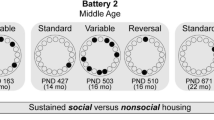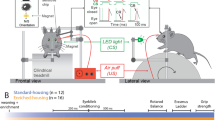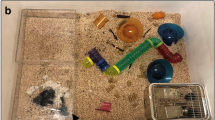Abstract
Environmental enrichment aims to improve the well-being of laboratory animals and provides an opportunity to improve experimental reliability and validity. Animals raised in more stimulating environments have improved learning and memory as well as more complex brain architecture. However, the effects of environmental enrichment on motor performance, anxiety and emotional development have been poorly studied. Moreover, most investigators studying the effects of enrichment provide extremely large and complex housing conditions to maximize the likelihood of finding effects. These situations are difficult to replicate across animal facilities and are not operationally practical. In this experiment, we investigated how simple, inexpensive disposable shelterstyle enrichment items alter behavior in C57Bl/6 and 129S6 mice. Breeding pairs were established in the presence of a Ketchum “Refuge”, Shepherd Shack “Dome”, or no enrichment. Offspring were assessed neurobehaviorally, either just after weaning (pre-adolescent, P22–P25), or as young adults (P60–P90). Major strain differences were observed in open field activity, elevated maze exploration, and Y-maze activity levels. The presence of the Refuge and/or Dome enrichment shelters significantly altered motor activity, coordination and some measures of anxiety. Mice housed in the presence of shelters were also less dominant than control mice in a tube test assay. Our experiments provide a detailed analysis of the effects of inexpensive and practical methods of housing enrichment on biobehavioral phenotypes in these two commonly used strains of laboratory mice, and suggest that the effects of these shelters on mouse neurobiology and behavior need to be rigorously analyzed before being adopted within vivariums.
Similar content being viewed by others
References
Garner J.P., Stereotypies and other abnormal repetitive behaviors: potential impact on validity, reliability, and replicability of scientific outcomes, ILAR J., 2005, 46, 106–117
Newberry R.C., Environmental enrichment — increasing the biological relevance of captive environments, Appl. Anim. Behav. Sci., 1995, 44, 229–243
Benaroya-Milshtein N., Apter A., Yaniv I., Kukulansky T., Raz N., Haberman Y., et al., Environmental enrichment augments the efficacy of idiotype vaccination for B-cell lymphoma, J. Immunother., 2007, 30, 517–522
Arranz L., De Castro N.M., Baeza I., Maté I., Viveros M.P., De la Fuente M., Environmental enrichment improves age-related immune system impairment: long-term exposure since adulthood increases life span in mice, Rejuvenation Res., 2010, 13, 415–428
Olsson I.A., Dahlborn K., Improving housing conditions for laboratory mice: a review of “environmental enrichment”, Lab. Anim., 2002, 36, 243–270
Gortz N., Lewejohann L., Tomm M., Ambree O., Keyvani K., Paulus W., et al., Effects of environmental enrichment on exploration, anxiety, and memory in female TgCRND8 Alzheimer mice, Behav. Brain Res., 2008, 191, 43–48
Froberg-Fejko K.M., Addressing the environmental enrichment needs of mice: thinking outside the cage, Lab. Anim., 2008, 37, 534–535
Laviola G., Hannan A.J., Macri S., Solinas M., Jaber M., Effects of enriched environment on animal models of neurodegenerative diseases and psychiatric disorders, Neurobiol. Dis., 2008, 31, 159–168
Thiriet N., Amar L., Toussay X., Lardeux V., Ladenheim B., Becker K.G., et al., Environmental enrichment during adolescence regulates gene expression in the striatum of mice, Brain Res., 2008, 1222, 31–41
Kawakami K., Shimosaki S., Tongu M., Kobayashi Y., Nabika T., Nomura M., et al., Evaluation of bedding and nesting materials for laboratory mice by preference tests, Exp. Anim., 2007, 56, 363–368
Deacon R.M., Housing, husbandry and handling of rodents for behavioral experiments, Nat. Protoc., 2006, 1, 936–946
Benaroya-Milshtein N., Hollander N., Apter A., Kukulansky T., Raz N., Wilf A., et al., Environmental enrichment in mice decreases anxiety, attenuates stress responses and enhances natural killer cell activity, Eur. J. Neurosci., 2004, 20, 1341–1347
Weed J.L., Raber J.M., Balancing animal research with animal wellbeing: establishment of goals and harmonization of approaches, ILAR J., 2005, 46, 118–128
Nithianantharajah J., Hannan A.J., Enriched environments, experience-dependent plasticity and disorders of the nervous system, Nat. Rev. Neurosci., 2006, 7, 697–709
Kondo M., Gray L.J., Pelka G.J., Christodoulou J., Tam P.P., Hannan A.J., Environmental enrichment ameliorates a motor coordination deficit in a mouse model of Rett syndrome—Mecp2 gene dosage effects and BDNF expression, Eur. J. Neurosci., 2008, 27, 3342–3350
Bredy T.W., Humpartzoomian R.A., Cain D.P., Meaney M.J., Partial reversal of the effect of maternal care on cognitive function through environmental enrichment, Neuroscience, 2003, 118, 571–576
Neugebauer N.M., Cunningham S.T., Zhu J., Bryant R.I., Middleton L.S., Dwoskin L.P., Effects of environmental enrichment on behavior and dopamine transporter function in medial prefrontal cortex in adult rats prenatally treated with cocaine, Dev. Brain Res., 2004, 153, 213–223
Venable N., Pinto-Hamuy T., Arraztoa J.A., Contador M.T., Chellew A., Peran C., et al., Greater efficacy of preweaning than postweaning environmental enrichment on maze learning in adult rats, Behav. Brain Res., 1988, 31, 89–92
Chourbaji S., Brandwein C., Vogt M.A., Dormann C., Hellweg R., Gass P., Nature vs. nurture: can enrichment rescue the behavioural phenotype of BDNF heterozygous mice?, Behav. Brain Res., 2008, 192, 254–258
Iwata E., Kikusui T., Takeuchi Y., Mori Y., Fostering and environmental enrichment ameliorate anxious behavior induced by early weaning in Balb/c mice, Physiol. Behav., 2007, 91, 318–324
Leger M., Paizanis E., Dzahini K., Quiedeville A., Bouet V., Cassel J.C., et al., Environmental enrichment duration differentially affects behavior and neuroplasticity in adult mice, Cereb. Cortex, 2014, pii, bhu119
Cabib S., Ventura R., Puglisi-Allegra S., Opposite imbalances between mesocortical and mesoaccumbens dopamine responses to stress by the same genotype depending on living conditions, Behav. Brain Res., 2002, 129, 179–185
Lehmann M.L., Herkenham M., Environmental enrichment confers stress resiliency to social defeat through an infralimbic cortex-dependent neuroanatomical pathway, J. Neurosci., 2011, 31, 6159–6173
Nader J., Chauvet C., Rawas R.E., Favot L., Jaber M., Thiriet N., et al., Loss of environmental enrichment increases vulnerability to cocaine addiction, Neuropsychopharmacology, 2012, 37, 1579–1587
Solinas M., Chauvet C., Thiriet N., El Rawas R., Jaber M., Reversal of cocaine addiction by environmental enrichment, Proc. Natl. Acad. Sci. USA, 2008, 105, 17145–17150
Febinger H.Y., George A., Priestley J., Toth L.A., Opp M.R., Effects of housing condition and cage change on characteristics of sleep in mice, J. Am. Assoc. Lab. Anim. Sci., 2014, 53, 29–37
Gustin R.M., Shonesy B.C., Robinson S.L., Rentz T.J., Baucum A.J.2nd, Jalan-Sakrikar N., et al., Loss of Thr286 phosphorylation disrupts synaptic CaMKIIalpha targeting, NMDAR activity and behavior in preadolescent mice, Mol. Cell. Neurosci., 2011, 47, 286–292
Carpenter A.C., Saborido T.P., Stanwood G.D., Development of hyperactivity and anxiety responses in dopamine transporter-deficient mice, Dev. Neurosci., 2012, 34, 250–257
Lister R.G., Ethologically-based animal models of anxiety disorders, Pharmacol. Ther., 1990, 46, 321–340
Shepherd J.K., Grewal S.S., Fletcher A., Bill D.J., Dourish C.T., Behavioural and pharmacological characterisation of the elevated “zero-maze” as an animal model of anxiety, Psychopharmacology, 1994, 116, 56–64
Rodgers R.J., Cutler M.G., Jackson J.E., Behavioural effects in mice of subchronic chlordiazepoxide, maprotiline and fluvoxamine. II. The elevated plus-maze, Pharmacol. Biochem. Behav., 1997, 57, 127–136
Frederick A.L., Stanwood G.D., Drugs, biogenic amine targets and the developing brain, Dev. Neurosci., 2009, 31, 7–22
Stanwood G.D., Levitt P., Waved-1 mutant mice are hypersensitive to the locomotor actions of cocaine, Synapse, 2007, 61, 259–262
Frederick A.L., Saborido T.P., Stanwood G.D., Neurobehavioral phenotyping of G(aq) knockout mice reveals impairments in motor functions and spatial working memory without changes in anxiety or behavioral despair, Front. Behav. Neurosci., 2012, 6, 29
Killinger C.E., Robinson S., Stanwood G.D., Subtle biobehavioral effects produced by paternal cocaine exposure, Synapse, 2012, 66, 902–908
McLaughlin B., Buendia M.A., Saborido T.P., Palubinsky A.M., Stankowski J.N., Stanwood G.D., Haploinsufficiency of the E3 ubiquitin ligase C-terminus of heat shock cognate 70 interacting protein (CHIP) produces specific behavioral impairments, PLoS One, 2012, 7, e36340
Veenstra-VanderWeele J., Muller C.L., Iwamoto H., Sauer J.E., Owens W.A., Shah C.R., et al., Autism gene variant causes hyperserotonemia, serotonin receptor hypersensitivity, social impairment and repetitive behavior, Proc. Natl. Acad. Sci. USA, 2012, 109, 5469–5474
Angoa-Pérez M., Kane M.J., Briggs D.I., Francescutti D.M., Kuhn D.M., Marble burying and nestlet shredding as tests of repetitive, compulsive-like behaviors in mice, J. Vis. Exp., 2013, 82, 50978
Shaw P., Gogtay N., Rapoport J., Childhood psychiatric disorders as anomalies in neurodevelopmental trajectories, Hum. Brain Mapp., 2010, 31, 917–925
Sullivan R., Wilson D.A., Feldon J., Yee B.K., Meyer U., Richter-Levin G., et al., The International Society for Developmental Psychobiology annual meeting symposium: impact of early life experiences on brain and behavioral development, Dev. Psychobiol., 2006, 48, 583–602
Andersen S.L., Stimulants and the developing brain, Trends Pharm. Sci., 2005, 26, 237–243
Abramov U., Puussaar T., Raud S., Kurrikoff K., Vasar E., Behavioural differences between C57BL/6 and 129S6/SvEv strains are reinforced by environmental enrichment, Neurosci. Lett., 2008, 443, 223–227
Augustsson H., van de Weerd H.A., Kruitwagen C.L., Baumans V., Effect of enrichment on variation and results in the light/dark test, Lab. Anim., 2003, 37, 328–340
Friske J.E., Gammie S.C., Environmental enrichment alters plus maze, but not maternal defense performance in mice, Physiol. Behav., 2005, 85, 187–194
Kulesskaya N., Rauvala H., Voikar V., Evaluation of social and physical enrichment in modulation of behavioural phenotype in C57BL/6J female mice, PLoS One, 2011, 6, e24755
Roy V., Belzung C., Delarue C., Chapillon P., Environmental enrichment in BALB/c mice: effects in classical tests of anxiety and exposure to a predatory odor, Physiol. Behav., 2001, 74, 313–320
Lin E.J., Choi E., Liu X., Martin A., During M.J., Environmental enrichment exerts sex-specific effects on emotionality in C57BL/6J mice, Behav. Brain Res., 2011, 216, 349–357
Zhu S.W., Yee B.K., Nyffeler M., Winblad B., Feldon J., Mohammed A.H., Influence of differential housing on emotional behaviour and neurotrophin levels in mice, Behav. Brain Res., 2006, 169, 10–20
Bats S., Thoumas J.L., Lordi B., Tonon M.C., Lalonde R., Caston J., The effects of a mild stressor on spontaneous alternation in mice, Behav. Brain Res., 2001, 118, 11–15
Hughes R.N., The value of spontaneous alternation behavior (SAB) as a test of retention in pharmacological investigations of memory, Neurosci. Biobehav. Rev., 2004, 28, 497–505
Lalonde R., The neurobiological basis of spontaneous alternation, Neurosci. Biobehav. Rev., 2002, 26, 91–104
Coutellier L., Wurbel H., Early environmental cues affect object recognition memory in adult female but not male C57BL/6 mice, Behav. Brain Res., 2009, 203, 312–315
Mesa-Gresa P., Pérez-Martinez A., Redolat R., Environmental enrichment improves novel object recognition and enhances agonistic behavior in male mice, Aggress. Behav., 2013, 39, 269–279
Haemisch A., Gartner K., The cage design affects intermale aggression in small groups of male laboratory mice: strain specific consequences on social organization, and endocrine activations in two inbred strains (DBA/2J and CBA/J), J. Exp. Anim. Sci., 1994, 36, 101–116
Haemisch A., Gartner K., Effects of cage enrichment on territorial aggression and stress physiology in male laboratory mice, Acta Physiol. Scand. Suppl., 1997, 640, 73–76
Haemisch A., Voss T., Gartner K., Effects of environmental enrichment on aggressive behavior, dominance hierarchies, and endocrine states in male DBA/2J mice, Physiol. Behav., 1994, 56, 1041–1048
Barnard C.J., Behnke J.M., Sewell J., Environmental enrichment, immunocompetence, and resistance to Babesia microti in male mice, Physiol. Behav., 1996, 60, 1223–1231
Andersen S.L., Trajectories of brain development: point of vulnerability or window of opportunity?, Neurosci. Biobehav. Rev., 2003, 27, 3–18
Knudsen E.I., Sensitive periods in the development of the brain and behavior, J. Cogn. Neurosci., 2004, 16, 1412–1425
Crawley J.N., Belknap J.K., Collins A., Crabbe J.C., Frankel W., Henderson N., et al., Behavioral phenotypes of inbred mouse strains: implications and recommendations for molecular studies, Psychopharmacology, 1997, 132, 107–124
Contet C., Rawlins J.N., Deacon R.M., A comparison of 129S2/SvHsd and C57BL/6JOlaHsd mice on a test battery assessing sensorimotor, affective and cognitive behaviours: implications for the study of genetically modified mice, Behav. Brain Res., 2001, 124, 33–46
Colacicco G., Welzl H., Lipp H.P., Wurbel H., Attentional set-shifting in mice: modification of a rat paradigm, and evidence for strain-dependent variation, Behav. Brain Res., 2002, 132, 95–102
Rodgers R.J., Davies B., Shore R., Absence of anxiolytic response to chlordiazepoxide in two common background strains exposed to the elevated plus-maze: importance and implications of behavioural baseline, Genes Brain Behav., 2002, 1, 242–251
Camp M., Norcross M., Whittle N., Feyder M., D’Hanis W., Yilmazer-Hanke D., et al., Impaired Pavlovian fear extinction is a common phenotype across genetic lineages of the 129 inbred mouse strain, Genes Brain Behav., 2009, 8, 744–752
Heinla I., Leidmaa E., Visnapuu T., Philips M.A., Vasar E., Enrichment and individual housing reinforce the differences in aggressiveness and amphetamine response in 129S6/SvEv and C57BL/6 strains, Behav. Brain Res., 2014, 267, 66–73
Author information
Authors and Affiliations
Corresponding author
About this article
Cite this article
Coke-Murphy, C., Buendia, M.A., Saborido, T.P. et al. Simple shelter-style environmental enrichment alters behavior in mice. Translat.Neurosci. 5, 185–196 (2014). https://doi.org/10.2478/s13380-014-0228-4
Received:
Accepted:
Published:
Issue Date:
DOI: https://doi.org/10.2478/s13380-014-0228-4




